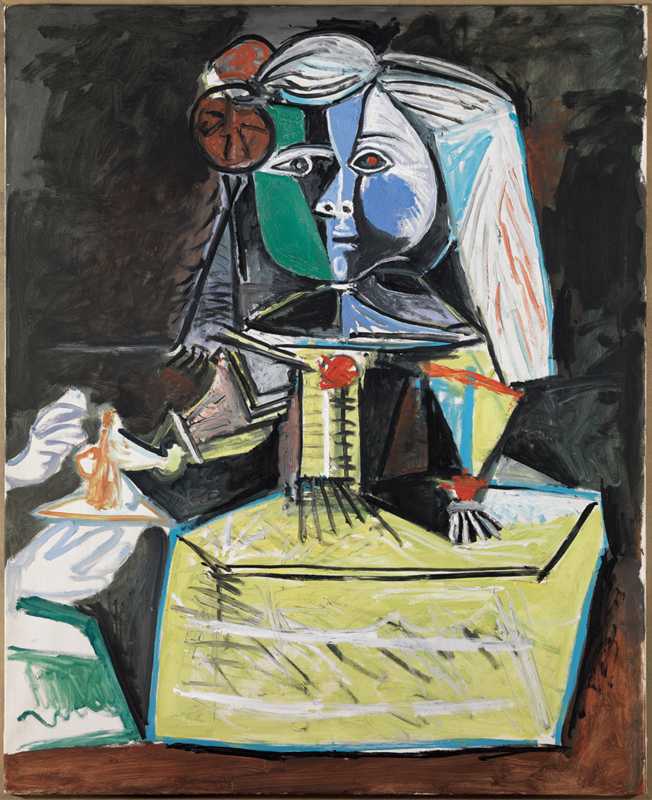 The Infanta Margarita by Diego Velasquez - Prado Museum - Madrid - Spain
The Infanta Margarita by Diego Velasquez - Prado Museum - Madrid - Spain
 Fermin Aguayo - Study Number 2
Fermin Aguayo - Study Number 2
 Infanta Margarita in pink - Jeanne Bucher Gallery - Paris
Infanta Margarita in pink - Jeanne Bucher Gallery - Paris
 Pablo Picasso - The Infanta Margarita - Museu Picasso - Barcelona - Spain
Pablo Picasso - The Infanta Margarita - Museu Picasso - Barcelona - Spain
Fermin Aguayo
65 x 50 cm
Plus d'images
-
(View a larger image of thumbnail 1
)

-
(View a larger image of thumbnail 2
)

-
(View a larger image of thumbnail 3
)

-
(View a larger image of thumbnail 4
)

-
(View a larger image of thumbnail 5
)

-
(View a larger image of thumbnail 6
)

-
(View a larger image of thumbnail 7
)

-
(View a larger image of thumbnail 8
)

-
(View a larger image of thumbnail 9
)

Provenance
Galerie Jeanne Bucher, Paris - "Aguayo" exhibition, October 1961, number 21; Hélène Bokanowski Collection
A breath of modernity animates this iconic work, inspired by Velázquez' portrait of the Infanta Margarita, which reveals the immense talent of the painter Fermin Aguayo, then in exile in Paris.
1. Fermin Aguayo, a Spanish painter in Paris
Born in 1926 in Sotillo, a small village in Castile, Fermin Aguayo had a difficult childhood, marked by the war. After his father and two brothers were shot in 1936 by the Francoists, he lived a wandering existence with his mother before settling in Zaragoza in 1938.
A self-taught painter, he began to paint around 1941, first in gouache and watercolour before tackling oil around 1945. In 1947, he was one of the founding members of the Portico group with six other painters, which claimed abstraction as its mode of expression, but the adventure was short-lived.
In 1952, he moved to Paris where he met his wife, Marguerite Legrand. He quickly became successful and exhibited for the first time in 1958 at the Galerie Jeanne Bucher, a gallery to which he remained faithful throughout his life and which organised twelve monographic exhibitions for him. In 1960, he abandoned abstraction and returned to figuration, drawing his inspiration in particular from the work of Velázquez. He died of cancer in Paris on 22 November 1977. The Reina Sofia Museum in Madrid held an important retrospective to him in 2005.
2. The Infanta Margarita, from Velázquez to the fascination of moderns
Our painting is a very personal interpretation, using shades of pink, brown and grey, of the portrait of the Infanta Margarita, one of Velázquez (1599 - 1660) masterpieces kept in the Prado Museum.
The First daughter of King Philip IV with his second wife, Marie-Anne of Austria, the Infanta married Emperor Leopold 1st and died at the age of 21. She is also the figure in the middle of Velázquez' most famous painting, the Meninas.
In 1957, Picasso tackled this icon of Spanish painting in order to radically renew the way we look at it. A 1957 painting in the Museu Picasso in Barcelona bears witness to this research.
Three years later, when Fermin Aguayo took his turn to tackle Velasquez, he was at a decisive turning point in his career, moving away from Cubism and returning to figuration. We do not know the exact number of studies after the portrait of the Infanta Margarita that were shown at the Galerie Jeanne Bucher exhibition in 1961, but it seems that the one presented here is one of the most successful.
It is interesting to note that the artist has profoundly altered the dimensions of Velázquez' work, focusing in on the figure of the Infanta, without all the space that overhangs her in the Prado portrait. The Infanta is depicted in a simulated frame whose colours are in harmony with those of the painting. As this frame is included in the canvas, we have kept the original presentation in which the canvas is simply inserted into a discreet light-coloured oak strip.
Aguayo synthesises the main decorative elements (skirt motifs, ear knot) into a harmonious composition that makes the Infanta immediately recognisable. The stripes on the skirt in this painting form an astonishing fishbone pattern of great decorative force. It seems that these studies constitute a step towards the larger formats also presented at the Galerie Jeanne Bucher in October 1961.
After Picasso and Aguayo, this fascination with Velasquez' work continued throughout modern Spanish art. For example, Salvador Dali's Pearl painted in 1981 (in which he plays on the etymology of the name Margarita)[1], or more recently the research of Manolo Valdés[2].
[1] https://www.salvador-dali.org/fr/oeuvre/catalogue-raisonne-peinture/obra/952/la-perle
[2] https://artvision360.com/en/the-universe-of-meninas-by-manolo-valdes/





